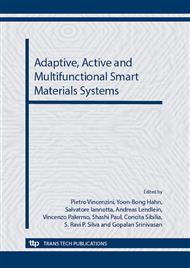p.41
p.47
p.53
p.59
p.65
p.71
p.77
p.82
p.86
Recent Progress in Disposable Ion-Selective Sensors for Environmental Applications
Abstract:
Solid-contact Ion Selective Electrodes (SC-ISEs) for the detection of lead are prepared on screen printed substrates in order to have low-cost and disposable sensors which may be useful in long-term environmental monitoring. It is shown that the materials used as solid contact layer, the deposition techniques and their thickness affect greatly the performances of the sensors. Poly(3-octylthiophene-2,5-diyl) (POT) and poly-3,4-ethylenedioxithiophene (PEDOT) are employed in this investigation. A trend showing an optimum is found for sensors prepared with POT as the batch reproducibility depends on the amount drop-cast, i.e., thickness. In case of PEDOT which is grown amperometrically the trend is more complex but an optimum for the batch reproducibility is again found depending on the current density. In the latter case, the film thickness and the overoxidation degree of the polymer probably concur in determining a more complex relationship.
Info:
Periodical:
Pages:
65-70
Citation:
Online since:
September 2012
Authors:
Price:
Сopyright:
© 2013 Trans Tech Publications Ltd. All Rights Reserved
Share:
Citation:


